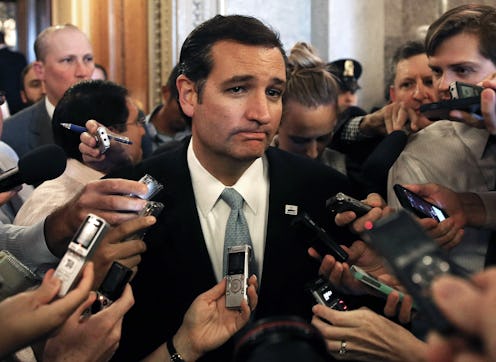News
Cruz Stops Talking, Obamacare Premiums Released
As Senator Ted Cruz continued to try to stall Obamacare Wednesday, a Department of Health and Human Services report was released, clarifying Obamacare premium rates for 36 states. The not-so shocking result? The price tag for premiums depends on the market, but is still lower than expected. The report is the first comprehensive look at Obamacare's figures and shows that costs will vary, depending on who's being covered and where they live. The average price of an unsubsidized, mid-tier health insurance plan under Obamacare? $328.
Cruz had launched an overnight assault on the proposed healthcare program, finally ending at noon Wednesday with an impassioned plea to "listen to the American people."
The figures comes in 16 percent lower than the government's own projections.
At either end of the spectrum, individuals could expect to pay as little as $70 — but premiums could run $1,200 for a family of four, according to the Department of Health and Human Services (HHS) report. However, if that family of four lives in Fairfax County, Va. and earns $50,000, they wouldn't have any premium at all, because a federal tax credit would pick up the tab.
"For millions of Americans these new options will finally make health insurance work within their budgets," HHS Secretary Kathleen Sebelius said at a press conference.
Enrollment for Obamacare opens Oct. 1, at the beginning of the new federal fiscal year. But as early as next Tuesday night, people can log on to government "marketplace" websites to check out plan options (Until then, you can go to the HHS report and click around on your state.) That said, plans won't kick in until next year — a start date that carries with it the requirement that all Americans have some sort of health insurance, or receive a fine.
Beginning Jan. 1, 2014, the federal government is set to operate the insurance exchange in 36 states, while the remaining 14 and Washington, D.C. will run their own. Plans will include basic benefits and must also offer mental health and maternity care — two additions not included in many private plans.
As part of cost-saving measures, insurance companies have narrowed in-network doctor and hospital choices, which means that some people who need to adopt the plan might need to switch doctors or see different specialists. Fewer doctors might mean longer waiting times as well, according to the Washington Post.
High deductibles, another concern for those opposed to the legislation, could surface in the lowest-cost plans. However, the Affordable Care Act legislation capped out-of-pocket expenses at $6,350 per person per year.
But what's really going to affect Obamacare costs is the same force as any other capital good: competition. The more people enrolled in a competitive market, the lower the prices will be kept. The government's hoping for seven million people the first year, with at least 2.7 million young, healthy people included in that figure to offset the costs for the others insured.
Prices will be higher in states with less competition, and lower in ones with more. Not surprisingly, states that have supported Obamacare are touting its affordability, while those that haven't have been telling consumers they're in for "rate shock."
However, Texas stands as the outlier: The red state has been anti-Obamacare from the get-go, but its rates come in below the average. In Austin, where 76 plans are available, a 27-year-old would pay $169/month for the lowest-cost mid-tier plan, according to the HHS report. In Dallas-Fort Worth, where there are 43 plans, it would run $217.
For some, the price tag could even be a little lower: 56 percent of the 41 million uninsured Americans eligible for the marketplaces could pay premiums of $100 or less each month, according to the HHS press release. But not everyone thinks the report is good news. A write-up by Avik Roy, who heads Forbes' health and entitlement column The Apothecary, says that "Based on a Manhattan Institute analysis of the HHS numbers, Obamacare will increase underlying insurance rates for younger men by an average of 97 to 99 percent, and for younger women by an average of 55 to 62 percent."
Obamacare, as it's now known, was signed into law as part of the Affordable Care Act, which passed back in 2010. Another pillar of the law, involving the expansion of Medicaid, will also take effect at the new calendar year.
